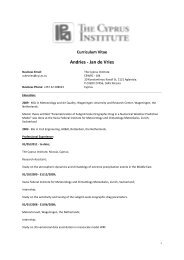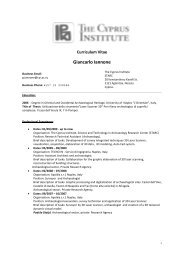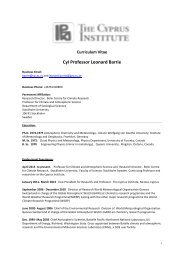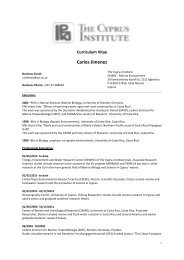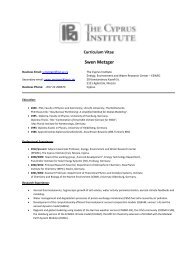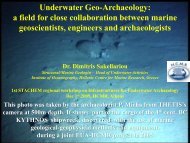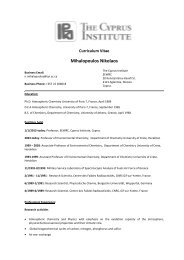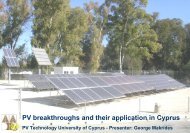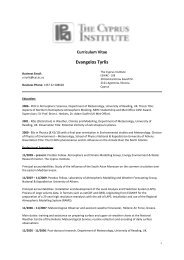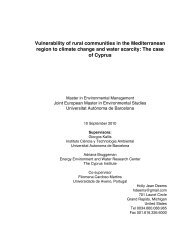high definition 3d-scanning of arts objects and paintings
high definition 3d-scanning of arts objects and paintings
high definition 3d-scanning of arts objects and paintings
You also want an ePaper? Increase the reach of your titles
YUMPU automatically turns print PDFs into web optimized ePapers that Google loves.
Structured Light <strong>and</strong> Laser Scanning 50<br />
HIGH DEFINITION 3D-SCANNING OF ARTS OBJECTS AND<br />
PAINTINGS<br />
Devrim AKÇA 1 , Armin GRÜN 1 , Bernd BREUCKMANN 2 , <strong>and</strong> Christian LAHANIER 3<br />
1 Institute <strong>of</strong> Geodesy <strong>and</strong> Photogrammetry, ETH Zurich, Switzerl<strong>and</strong>,<br />
(akca, agruen)@geod.baug.ethz.ch<br />
2 Breuckmann GmbH, Meersburg, Germany<br />
bernd.breuckmann@breuckmann.com<br />
3 Centre de Rcherche et de Restauration des Musées de France, France<br />
christian.lahanier@culture.gouv.fr<br />
KEY WORDS: Cultural heritage, coded structured light, digitization, modeling, point cloud.<br />
ABSTRACT<br />
3D documentation <strong>and</strong> visualization <strong>of</strong> Cultural Heritage <strong>and</strong> Arts <strong>objects</strong> is an exp<strong>and</strong>ing<br />
application area. The selection <strong>of</strong> the right technology for these kinds <strong>of</strong> applications is very<br />
important <strong>and</strong> strictly related to the project requirements, budget <strong>and</strong> user’s experience. In this<br />
contribution, we report our experience in the 3D digitization <strong>of</strong> three <strong>objects</strong>: a Herakles statue, a<br />
Khmer head <strong>and</strong> a painting. We cover all the necessary steps <strong>of</strong> the 3D object modeling pipeline<br />
with structured light technique <strong>and</strong> we discuss the capabilities <strong>of</strong> the used technology.<br />
1 INTRODUCTION<br />
Topometrical <strong>high</strong> <strong>definition</strong> 3D-scanners, optimized for the requirements <strong>of</strong> <strong>arts</strong> <strong>and</strong> cultural<br />
heritage, allow the 3-dimensional digitization <strong>of</strong> art <strong>objects</strong> <strong>and</strong> <strong>paintings</strong> with <strong>high</strong> resolution <strong>and</strong><br />
accuracy. Moreover, the texture <strong>and</strong>/or color <strong>of</strong> the object can be recorded, <strong>of</strong>fering a one-to-one<br />
correspondence <strong>of</strong> 3D coordinate <strong>and</strong> color information.<br />
Topometrical scanners are based on the principal <strong>of</strong> optical triangulation using structured light: A<br />
special projection unit projects a known pattern <strong>of</strong> light onto the object. A digital camera records<br />
the image <strong>of</strong> the object together with the projected pattern.<br />
State <strong>of</strong> the art systems (as Breuckmann optoTOP-HE, optoTOP-SE, triTOS) use special projection<br />
patterns with a combined Gray Code / phaseshift technique, which guarantees an unambiguous<br />
determination <strong>of</strong> the recorded 3D-data with <strong>high</strong>est accuracy. The time for a single scan takes about<br />
1 second for a 1.4 M pixel camera <strong>and</strong> a few seconds for <strong>high</strong> <strong>definition</strong> cameras with 4-8 M pixel.<br />
(a) (b) (c)<br />
Figure 1. (a) Weary Herakles statue in the Antalya Museum, (b) Khmer head in the Rietberg Museum, Zurich, (c) Lady<br />
Praying painting in the Louvre Museum, Paris.
Akça, Grün, et al. 51<br />
This paper reports about three case studies where three different models <strong>of</strong> Breuckmann topometric<br />
scanners (optoTOP-HE, optoTOP-SE, <strong>and</strong> triTOS) are used for the precise 3D digitization <strong>and</strong><br />
documentation <strong>of</strong> Cultural Heritage <strong>and</strong> Arts <strong>objects</strong>. It includes all necessary steps <strong>of</strong> the 3D object<br />
modeling pipeline from data acquisition to 3D visualization.<br />
The first study is the 3D modeling <strong>of</strong> a part <strong>of</strong> a marble Herakles statue, named “Weary Herakles”<br />
(Fig. 1a), which is on display in the Antalya Museum (Turkey), digitized with an optoTOP-HE<br />
system. The second case is about the 3D modeling <strong>of</strong> a Khmer head sculpture (Fig. 1b), which is in<br />
the collection <strong>of</strong> Rietberg Museum (Zurich, Switzerl<strong>and</strong>), digitized using an optoTOP-SE sensor.<br />
The third study is the <strong>high</strong> <strong>definition</strong> digitization <strong>and</strong> modeling <strong>of</strong> the painting Lady Praying (Fig.<br />
1c) in the Louvre Museum (Paris, France) using a triTOS sensor.<br />
The next chapter introduces the scanner with emphasis on the working principle <strong>and</strong> technical<br />
specifications. The following chapters explain the data acquisition <strong>and</strong> modeling workflow <strong>of</strong> the<br />
Weary Herakles, Khmer head <strong>and</strong> Lady Praying projects, respectively.<br />
2 DATA ACQUISITION SYSTEM<br />
2.1 Coded Structured Light System<br />
The active stereo vision method, also called the structured light system, deals with the 3D object<br />
reconstruction task. The key feature <strong>of</strong> the system is the replacement <strong>of</strong> one <strong>of</strong> the cameras by an<br />
active light source, which illuminates the object with a known pattern. This solves the<br />
correspondence problem in a direct way. Many variants <strong>of</strong> the active light source exist (Beraldin,<br />
2004; Blais, 2004).<br />
The coded structured light technique, also called topometric technique, is based on a unique<br />
codification <strong>of</strong> each light token projected onto object. When a token is detected in the image, the<br />
correspondence is directly solved by the de-codification. It requires a complex light projection<br />
system. There exist many codification methods (Salvi et al., 2004; Dip<strong>and</strong>a <strong>and</strong> Woo, 2005).<br />
The time-multiplexing, also called temporal<br />
codification, with a combined Gray code <strong>and</strong><br />
phase shifting is the mostly employed<br />
technique. The optoTOP-HE/SE <strong>and</strong> triTOS<br />
sensors use the same technique.<br />
A Gray code is a binary numeral system where<br />
two successive values differ in only one digit,<br />
i.e. 000, 001, 010, 011, … in natural (plain)<br />
(a)<br />
(b) (c)<br />
Figure 2. (a) Setup <strong>of</strong> a fringe projection system with the<br />
natural binary codification, (b) natural binary code, (c) Gray<br />
binary code.<br />
binary codes, <strong>and</strong> 000, 001, 011, 010, … in<br />
Gray binary codes. It was invented <strong>and</strong><br />
patented by Frank Gray (Gray, 1953) in Bell<br />
Labs. For the case <strong>of</strong> coded structured light<br />
systems it is superior to the natural binary<br />
codification, since it resolves the ambiguity<br />
better at the edges <strong>of</strong> consecutive patterns (Fig.<br />
2b <strong>and</strong> 2c).<br />
A sequence <strong>of</strong> Gray coded binary fringe<br />
patterns is projected onto the object (Fig. 2a).<br />
This divides the object into a number <strong>of</strong> 2 n<br />
sections, where n is the number <strong>of</strong> pattern sequences, e.g. 128 sections for n = 7. Thus each pixel is<br />
associated with a codeword, which is the sequence <strong>of</strong> 0s <strong>and</strong> 1s obtained from the n patterns. The<br />
codeword establishes the correspondences relating the image pixels to the projector stripe numbers.<br />
The object space point coordinates are calculated using the spatial intersection provided that system
Structured Light <strong>and</strong> Laser Scanning 52<br />
calibration is known. All pixels belonging to the same stripe in the <strong>high</strong>est frequency pattern share<br />
the same codeword. This limits the resolution to half the size <strong>of</strong> the finest pattern.<br />
An additional periodical pattern is projected several times by shifting it in one direction in order to<br />
increase the resolution <strong>of</strong> the system. For each camera pixel the corresponding projector stripe<br />
number with sub-stripe accuracy is yielded by a phase shift method Gühring (2001).<br />
2.2 Brecukmann optoTOP-HE, optoTOP-SE <strong>and</strong> triTOS systems<br />
The optoTOP-HE system (Fig. 3), as a <strong>high</strong> <strong>definition</strong> topometrical 3D-scanner, allows the <strong>3d</strong>imensional<br />
digitization <strong>of</strong> <strong>objects</strong> with <strong>high</strong> resolution <strong>and</strong> accuracy. The optoTOP-HE system<br />
uses special projection patterns with a combined Gray code <strong>and</strong> phase shift technique, which<br />
guarantees an unambiguous determination <strong>of</strong> the recorded 3D data with <strong>high</strong>est accuracy<br />
(Breuckmann, 2003). The sensor <strong>of</strong> the optoTOP-HE system can be scaled for a wide range <strong>of</strong> Field<br />
<strong>of</strong> Views (FOV), by changing the baseline distance <strong>and</strong>/or lenses, typically between a few<br />
centimeters up to several meters. Thus the specifications <strong>of</strong> the sensor can be adapted to the special<br />
dem<strong>and</strong>s <strong>of</strong> a given measuring task.<br />
(a) (b)<br />
Figure 3. (a) The optoTOP-HE sensor, (b) <strong>and</strong> its first 3 fringe projections.<br />
The optoTOP-SE (Special Edition) series are the identical systems. The major difference is that the<br />
optoTOP–SE sensors have only three different FOV cases with a fixed 300 mm base length. The<br />
triTOS sensors are specially designed for the Cultural Heritage tasks. Details are given in Table 1.<br />
Table 1. Technical specifications <strong>of</strong> the used optoTOP-HE/–SE <strong>and</strong> triTOS sensors.<br />
optoTOP-HE optoTOP-SE (3) triTOS (3)<br />
Field <strong>of</strong> View (mm) 480x360 400x315 80x60<br />
Depth <strong>of</strong> View (mm) 320 260 40<br />
Acquisition time (sec)
Akça, Grün, et al. 53<br />
along with a photograph <strong>of</strong> the top half (Fig. 1a). According to the mythology Herakles is the<br />
symbol <strong>of</strong> power. He killed the Nemean lion, which was a nuisance in Greece. He used the skin <strong>of</strong><br />
the lion as armor.<br />
Because <strong>of</strong> the Turkish laws, the government has asked for restitution <strong>of</strong> the upper half so that the<br />
two fragments can be joined. The MFA has refused to consider Turkish petition. In 1992, casts <strong>of</strong><br />
the two fragments were placed together. They were found to match perfectly. The MFA says the<br />
statue may have broken in ancient times, <strong>and</strong> the upper torso may have been taken from Turkey<br />
before Turkish law established state ownership <strong>of</strong> archaeological finds (Gizzarelli, 2006).<br />
Since both p<strong>arts</strong> are unfortunately separated geographically, our aim was to record <strong>and</strong> model both<br />
the lower <strong>and</strong> the upper part <strong>and</strong> bring these partial models together in the computer, so that at least<br />
there the complete statue could be seen, appreciated <strong>and</strong> analyzed. With the help <strong>of</strong> the Turkish<br />
authorities <strong>and</strong> the Antalya Museum we were able to complete our work on the lower part, but<br />
access to the Boston Museum was denied.<br />
The digitization <strong>of</strong> the lower part <strong>of</strong> the statue was done in 19-20 September 2005 in the Antalya<br />
Museum with a Breuckmann optoTOP-HE structured light system. The system was kindly provided<br />
by the Turkish reseller InfoTRON, Istanbul. Further information can be found on the project<br />
webpage: http://www.photogrammetry.ethz.ch/research/herakles/.<br />
3.1 Scanning in the Antalya Museum<br />
The <strong>scanning</strong> campaign was completed in one <strong>and</strong> a half days <strong>of</strong> work. The statue is around 1.1<br />
meters in height. The whole object was covered with 56 scans <strong>of</strong> the first day work. The remaining<br />
11 scans <strong>of</strong> the second day were for filling the data holes <strong>and</strong> occlusion areas. Totally 83.75M<br />
points were acquired in 67 scan files.<br />
3.2 Pointcloud registration<br />
The pairwise registration was done by use <strong>of</strong> an in-house developed method, called Least Squares<br />
3D Surface Matching (LS3D). The mathematical model is a generalization <strong>of</strong> the Least Squares<br />
image matching method, in particular the method given by Gruen (1985). It provides mechanisms<br />
for internal quality control <strong>and</strong> the capability <strong>of</strong> matching <strong>of</strong> multi-resolution <strong>and</strong> multi-quality data<br />
sets. For details, we refer to Gruen <strong>and</strong> Akca (2005). The pairwise LS3D matchings are run on<br />
every overlapping pairs (totally 234) <strong>and</strong> a subset <strong>of</strong> point correspondences are saved to separate<br />
files. The average <strong>of</strong> the sigma naught value is 81 microns. In the global registration step, all these<br />
files are passed to a block adjustment by independent models procedure, which is a well known<br />
orientation procedure in photogrammetry. It concluded with 47 micron a posteriori sigma naught<br />
value.<br />
3.3 Surface Triangulation <strong>and</strong> Editing<br />
After the registration step, all scan files were merged <strong>and</strong> imported to Geomagic Studio 6<br />
(Raindrop Geomagic Inc.) modeling package. The data set was cropped to include only the area <strong>of</strong><br />
interest (AOI), concluding with 33.9 M points. A low level noise reduction was applied. The<br />
number <strong>of</strong> points was reduced to 9.0 million by applying a subsampling procedure based on<br />
curvature information. This operation eliminates points in flat regions but preserves points in <strong>high</strong><br />
curvature regions to maintain detail. The surface triangulation concluded with 5.2 M triangles (Fig.<br />
4). Because <strong>of</strong> the complexity <strong>of</strong> the statue <strong>and</strong> occlusions, some inner concave p<strong>arts</strong> could not be<br />
seen by the scanner. This resulted in several data holes on the triangulated surface. They were<br />
interactively filled by use <strong>of</strong> the corresponding functions <strong>of</strong> Geomagic Studio.
Structured Light <strong>and</strong> Laser Scanning 54<br />
3.4 Texture Mapping <strong>and</strong> Visualization<br />
Separately taken images, with a 4M pixel CCD Leica Digilux 1 camera, were used for the texture<br />
mapping. The Weaver module <strong>of</strong> the VCLab’s 3D Scanning Tool (ISTI-CNR, Pisa, Italy) was used<br />
here. The VCLab’s Tool is a bundle <strong>of</strong> modules, which comprise the fundamental steps <strong>of</strong> the 3D<br />
modeling. The algorithmic details <strong>of</strong> the s<strong>of</strong>tware can be found in Callieri et al. (2003).<br />
The visualization <strong>of</strong> the final model was done with the IMView module <strong>of</strong> PolyWorks<br />
(InnovMetric S<strong>of</strong>tware Inc., version 9.0.2). It gives better shading than Geomagic Studio. The<br />
textured model was visualized with the viewer <strong>of</strong> the VCLab’s Tool (Fig. 4).<br />
Figure 4. Frontal view <strong>of</strong> the texture mapped model (left), frontal view (central) <strong>and</strong> back view (right) <strong>of</strong> the grey<br />
shaded model.<br />
4 KHMER HEAD PROJECT<br />
A bodhisattva head from the late 12th or early 13th century carved in the Bayon style was scanned<br />
in Museum Rietberg Zurich (Fig. 1b). It is Lokeshvara or Avalokiteshvara, the “Lord <strong>of</strong><br />
compassion who looks down (on the suffering <strong>of</strong> the world),” an emanation <strong>of</strong> the Buddha<br />
Amitabha as demonstrated by the seated Buddha on his hair ornament. Further information can be<br />
found on the project webpage: http://www.photogrammetry.ethz.ch/research/khmer/.<br />
4.1 Data Acquisition in Museum Rietberg<br />
The head is made <strong>of</strong> s<strong>and</strong>stone <strong>and</strong> 28 centimeters in height. The data acquisition was done in<br />
Museum Rietberg on 4 May 2006. A Breuckmann OptoTOP-SE fringe projection system was used<br />
for this purpose. The <strong>scanning</strong> <strong>and</strong> imaging took four hours on site work. The head was covered<br />
with 18 point clouds, totally 23.6 million points.<br />
4.2 Pointcloud registration<br />
The point cloud registration was done again with the LS3D surface matching method. 52 pairwise<br />
LS3D matchings for all overlaps gave an average sigma naught value <strong>of</strong> 60 microns. The global
Akça, Grün, et al. 55<br />
registration with the block adjustment by independent models solution concluded with 28 microns<br />
sigma naught value.<br />
4.3 Surface Triangulation <strong>and</strong> Editing<br />
The surface modeling was done by use <strong>of</strong> two commercial packages, namely Geomagic Studio <strong>and</strong><br />
Polyworks. The aim was to compare the capabilities <strong>of</strong> both s<strong>of</strong>twares. Registered point clouds<br />
were imported in the proper formats. Accordingly, the registration steps were skipped in both<br />
s<strong>of</strong>twares.<br />
Geomagic Studio <strong>of</strong>fers fully automatic data import functionality provided that data is given in one<br />
<strong>of</strong> the appropriate point cloud formats. Totally 18 point clouds were imported, merged into one,<br />
which gave a very dense (denser than 50 microns inter-point distance at some locations) point<br />
cloud. After discarding the no data or scanner signed erroneous points <strong>and</strong> points belonging to<br />
background <strong>and</strong> other non relevant <strong>objects</strong>, 3.2 million points remained.<br />
The noise reduction ensures that points coming from different views in different quality will finally<br />
have the similar signal-to-noise ratio. Here a slight (low level) noise reduction was applied. After<br />
this step, the model contains <strong>high</strong>ly redundant points coming from the multiple views. A curvature<br />
based subsampling procedure was performed, reducing the number <strong>of</strong> points to 1.9 millions.<br />
The surface triangulation in Geomagic Studio is fully 3D <strong>and</strong> automatic, with limited user<br />
interaction. Hence, the resulting mesh will have topological errors <strong>and</strong> holes. On the other h<strong>and</strong>, it<br />
can preserve the <strong>high</strong> frequency details <strong>of</strong> the object geometry successfully by considering all<br />
points in one processing sweep. In general, surface triangulation quality is <strong>high</strong>ly related to the<br />
point density <strong>and</strong> homogeneity.<br />
Figure 5. Shaded view <strong>of</strong> the model from Geomagic Studio (left) <strong>and</strong> PolyWorks (centre), texture mapped 3D model<br />
(right).<br />
PolyWorks has a significantly different workflow. Each step is represented as a module inside the<br />
package. Data import is not automatically performed. Each point cloud is individually imported,<br />
subsequently converted to the surface form by applying a 2.5D triangulation, similar to the terrain<br />
modeling case. Therefore, the user should interactively rotate the point cloud to a position where the<br />
viewing angle is close to the one at the acquisition instant. It substantially reduces the topological<br />
errors. On the opposite side, such a stepwise surface generation strategy does not utilize all the<br />
available information properly. For example, there might be some object p<strong>arts</strong> with thin point
Structured Light <strong>and</strong> Laser Scanning 56<br />
distributions in individual views, whereas the combination <strong>of</strong> all views together provides a good<br />
solution.<br />
At the next step, separate surfaces were merged as one manifold using the IMMerge module. This<br />
part is <strong>high</strong>ly automated, <strong>and</strong> additionally <strong>of</strong>fers a noise reduction option. During the process,<br />
triangulation is also optimized especially at the overlapping regions by associating dense triangles<br />
to <strong>high</strong> curvature areas <strong>and</strong> sparse at flat areas.<br />
The IMEdit module <strong>of</strong>fers many surface editing functions, e.g. cropping the AOI, filling the data<br />
holes, correcting the wrong triangles, boundary cleaning, etc. However, it is less flexible <strong>and</strong> user<br />
friendly than Geomagic Studio.<br />
The resulting models from both s<strong>of</strong>tware packages meet the project requirements. PolyWorks<br />
model (0.6 million triangles) has substantially less number <strong>of</strong> triangles than Geomagic model (3.9<br />
million triangles), thus having a better <strong>and</strong> optimized triangulation algorithm. However, the model<br />
from Geomagic Studio preserves the small details <strong>and</strong> structures slightly better than the model <strong>of</strong><br />
PolyWorks (Fig. 5).<br />
Although surface digitization is a very easy <strong>and</strong><br />
straightforward task, the surface triangulation <strong>and</strong><br />
editing, which is the key step <strong>of</strong> the whole<br />
modeling chain, is still cumbersome <strong>and</strong> needs<br />
heavy semi-automatic or manual work. The<br />
management <strong>of</strong> large data sets is another aspect.<br />
Geomagic Studio crushed several times while<br />
filling the holes interactively, whereas<br />
PolyWorks did not.<br />
Figure 6. Illumination system used for the texture<br />
mapping<br />
4.4 Texture Mapping<br />
A photographer type <strong>of</strong> pr<strong>of</strong>essional illumination<br />
system consisting <strong>of</strong> two diffuse lights on a tripod<br />
was used (Fig. 6). It reduces the radiometric<br />
differences between the images <strong>and</strong> shadow<br />
effects at the complex p<strong>arts</strong> <strong>and</strong> object silhouettes. Images were taken by a Sony DSC-W30 6<br />
megapixel digital camera. The PolyWorks model was used for the texture mapping in the original<br />
resolution. An in-house developed texture mapping method was employed. Details can be found in<br />
Akca et al. (2007).<br />
5 LADY PRAYING PROJECT<br />
Topometrical sensors can be scaled for a wide range <strong>of</strong> Field <strong>of</strong> View´s (FOV), typically between a<br />
few centimeters up to several meters. Thus, the specifications <strong>of</strong> the sensor can be adapted to the<br />
special dem<strong>and</strong>s <strong>of</strong> a given measuring task. The third case study reports about one <strong>of</strong> the first<br />
attempts for the <strong>high</strong> <strong>definition</strong> digitization <strong>of</strong> <strong>paintings</strong>, Lady Praying (Fig. 7), Louvre museum,<br />
inventory number RF 2090, anonymous artist, 1575-1599. For this work, which was carried out in<br />
collaboration with the Centre de Rcherche et de Restauration des Musées de France (C2RMF), a<br />
triTOS sensor with a 1.4 MPixel color camera <strong>and</strong> a field <strong>of</strong> view <strong>of</strong> 80 x 60 mm has been used,<br />
resulting in a spatial resolution <strong>of</strong> approximately 60 µm <strong>and</strong> a depth resolution <strong>of</strong> about 3 µm. The<br />
painting with a size <strong>of</strong> about 200 x 300 mm has been digitized with about 25 images. Although the<br />
depth differences <strong>of</strong> the painting (including background ) is only in the order <strong>of</strong> 100 µm up to 1<br />
mm, it is possible to align the different images unambiguously just by using this small 3Dinformation.<br />
The associated s<strong>of</strong>tware <strong>of</strong> the scanner (OPTOCAT) <strong>of</strong>fers a bundle <strong>of</strong> post processing functions,<br />
e.g. for the generation <strong>of</strong> a combined polygon mesh (merging), calculation <strong>of</strong> cross sections, data
Akça, Grün, et al. 57<br />
reduction/compressing, filtering <strong>and</strong> hole filling. For the detailed analysis <strong>of</strong> the relief <strong>of</strong> <strong>paintings</strong>,<br />
additional functions are available, which allow to separate the relief to be analyzed from the<br />
background structure by compensating the overall shape <strong>of</strong> the painting. The resulting depth<br />
information <strong>of</strong> the relief may be magnified <strong>and</strong> displayed quantitatively as shading plot or via<br />
pseudo colors.<br />
Figure 7. Recorded 3D model with color (left), 3D data after background compensation (middle), face, Z co-ordinate<br />
magnified by a factor <strong>of</strong> 50 (right ).<br />
6 CONCLUSIONS<br />
Active sensors are used for many kinds <strong>of</strong> 3D object reconstruction tasks, one important area <strong>of</strong><br />
which is 3D documentation <strong>of</strong> Cultural Heritage <strong>objects</strong>. This study presents the results <strong>of</strong> 3D<br />
modeling <strong>of</strong> three Cultural Heritage <strong>and</strong> Arts <strong>objects</strong>, where a close-range coded structured light<br />
system was used for digitization.<br />
The systems have acquired <strong>high</strong> quality point cloud data <strong>of</strong> the <strong>objects</strong>. The results <strong>of</strong> the<br />
processing (accuracy <strong>of</strong> about 50 micron for the Herakles statue <strong>and</strong> the Khmer head <strong>and</strong> 15 micron<br />
for the painting) are in good agreement with the system specifications. The heaviest user interaction<br />
is needed in the editing steps, e.g. for filling the data holes. We have used several commercial<br />
s<strong>of</strong>tware packages in order to carry out the modeling. Each s<strong>of</strong>tware package has its own particular<br />
advantages <strong>and</strong> functions. A unique package, which fulfills all requirements with sophisticated <strong>and</strong><br />
automatic editing capabilities, is not available. The usage <strong>of</strong> all three packages can give the optimal<br />
modeling results. Texture mapping is another issue, which is not fully supported by either s<strong>of</strong>tware.<br />
Active sensing with coded structured light systems is a mature technology <strong>and</strong> allows <strong>high</strong><br />
resolution documentation <strong>of</strong> cultural heritage <strong>objects</strong>.<br />
REFERENCES<br />
1. Akca, D., Remondino, F., Novàk, D., Hanusch, T., Schrotter, G., <strong>and</strong> Gruen, A., 2007.<br />
Performance evaluation <strong>of</strong> a coded structured light system for cultural heritage applictions.<br />
Videometrics IX, San Jose (California), USA, January 29-30, SPIE vol. 6491, pp. 64910V-1-12.<br />
2. Beraldin, J.-A., 2004. Integration <strong>of</strong> laser <strong>scanning</strong> <strong>and</strong> close-range photogrammetry – The last<br />
decade <strong>and</strong> beyond. IAPRS & SIS 35(B7), 972-983.<br />
3. Blais, F., 2004. Review <strong>of</strong> 20 years <strong>of</strong> range sensor development. Journal <strong>of</strong> Electronic Imaging<br />
13(1), 231-240.
Structured Light <strong>and</strong> Laser Scanning 58<br />
4. Breuckmann, B., 2003. State <strong>of</strong> the art <strong>of</strong> topometric 3D-metrology. Optical 3-D Measurement<br />
Techniques VI, Zurich, Switzerl<strong>and</strong>, Sept. 22-25, Vol. II, pp. 152-158.<br />
5. Callieri, M., Cignoni, P., Ganovelli, F., Montani, C., Pingi, P., Scopigno, R., 2003. VCLab’s<br />
Tools for 3D range data processing. VAST’03, Brighton, UK, Nov. 5-7, pp. 13-22.<br />
6. Dip<strong>and</strong>a, A., <strong>and</strong> Woo, S., 2005. Efficient correspondence problem-solving in 3-D shape<br />
reconstruction using a structured light system. Optical Engineering 44(9), 1-14.<br />
7. Gizzarelli, C., 2006. ‘Weary Herakles’: Looters vs. Archaeologists,<br />
http://www.bellaonline.com/articles/art28239.asp (accessed 6 April 2006).<br />
8. Gray, F., 1953. Pulse code communication. March 17, 1953, US Patent no. 2,632,058.<br />
9. Gruen, A., 1985. Adaptive least squares correlation: a powerful image matching technique.<br />
South Afr. J. <strong>of</strong> Photogrammetry, Remote Sensing <strong>and</strong> Cartography 14(3), 175-187.<br />
10. Gruen, A., <strong>and</strong> Akca, D., 2005. Least squares 3D surface <strong>and</strong> curve matching. ISPRS Journal <strong>of</strong><br />
Photogrammetry <strong>and</strong> Remote Sensing 59(3), 151-174.<br />
11. Gühring, J., 2001. Dense 3-D surface acquisition by structured light using <strong>of</strong>f-the-shelf<br />
components. Videometrics, San Jose, CA, January 22-23, pp. 220-231.<br />
12. Salvi, J., Pages, J., <strong>and</strong> Batlle, J., 2004. Pattern codification strategies in structured light<br />
systems. Pattern Recognition 37(4), 827-849.



